Revolvers that start with "D"
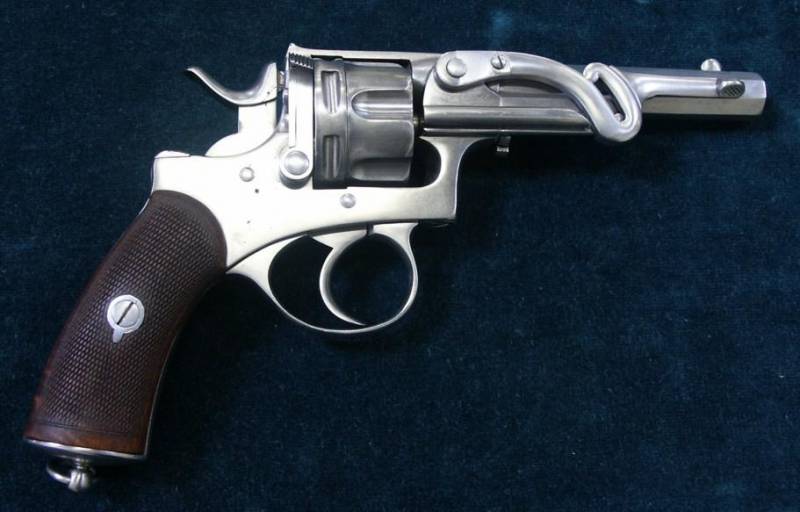
Helped me leave
Repeater Colt
It doesn't misfire.
Spin the drum
Six rounds,
The seventh day will come,
And the trumpet call
Destroy Jericho.
Ildus Farrakhov
ancient weapon from A to Z. So, we again turn to weapons with a short barrel and cartridges in a drum magazine behind the barrel.
This weapon has many advantages, but also many disadvantages. There are especially many of them in revolvers from the mid-XNUMXth century.
Firstly, these are the dimensions, especially if the revolver fires Lefoshe cartridges, that is, “mine with a pin” cartridges or they are also called “pin cartridges”. The pins must be covered with a lid so that they cannot catch on anything, and then empty cartridges from such cartridges are difficult to remove - there is nothing to catch on them.
There is one more serious drawback, characteristic of both capsule revolvers, and pinion-type, and cartridge-type revolvers. It's a "double shot"! After all, gases from a revolver when fired come out not only through the barrel, but also into the gap between the barrel and the drum. And this is quite unpleasant. Especially if you shoot in the dark.
Later, Henri Pieper will find a way to get rid of this shortcoming, but so far none of the gunsmiths have thought of this. True, it was Collier, the author of the flintlock revolver at the beginning of the century, who came up with the idea of sliding the drum onto the barrel, but for some reason the creators of subsequent systems forgot about this.
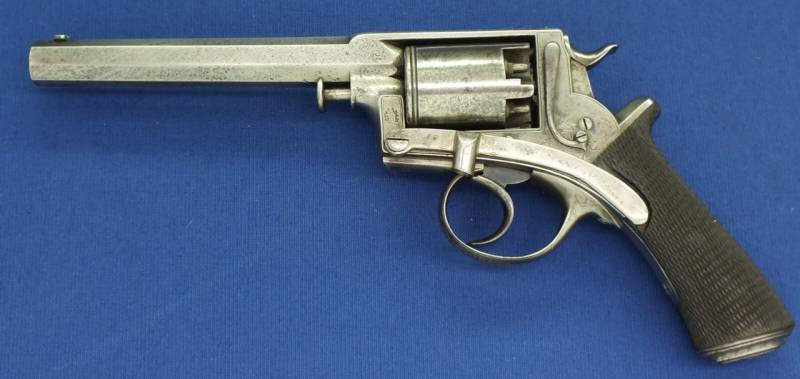
Revolver Celestin Dandois
There is nothing like this on our first revolver today, Celestin Dandois from Liege. His revolver was made under Adams' patent No. 4681 of 1851.
This is a 5-shot, 54-caliber (13,7 mm) percussion revolver. Length 33,5 cm. And in all respects it would be an “Adams revolver” if not for the “inflammator”. It is an original design, and has never been seen on any other revolver. It was a good idea though!
By the way, Celestin himself became the first general director of the Liege Firearms Factory, that is, in all respects he made an excellent career.
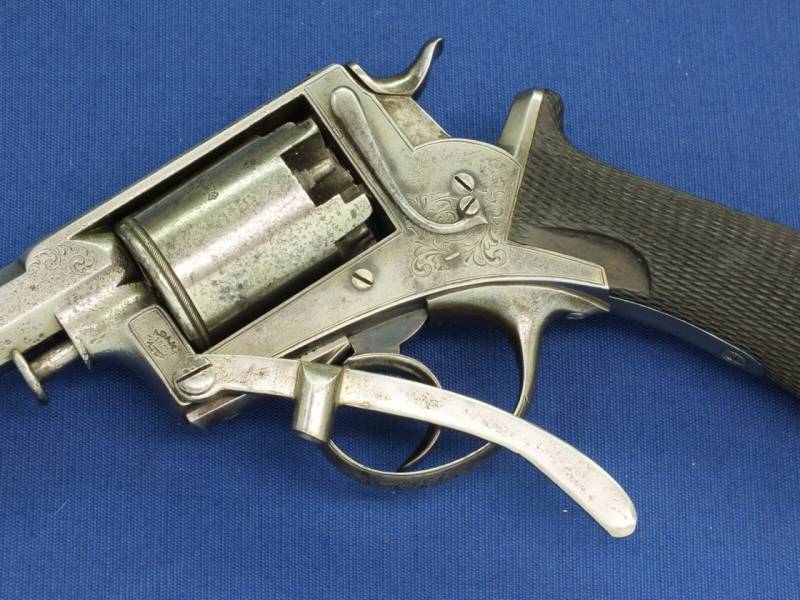
And this is how the inflamer worked on it!
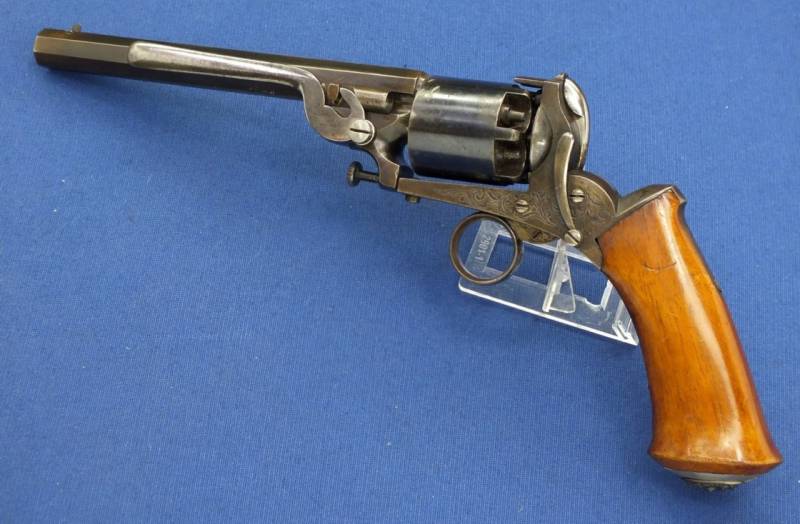
David Hermann's revolver
In principle, the revolver is ordinary, with a capsule. Caliber 9 mm. Length 35 cm. And again, the main difference from all other samples of the mid-XNUMXth century is the spray gun! The firing lever on Adams' revolver was also located along the barrel.
But for Hermann it worked a little differently, and this was quite enough to obtain a patent!
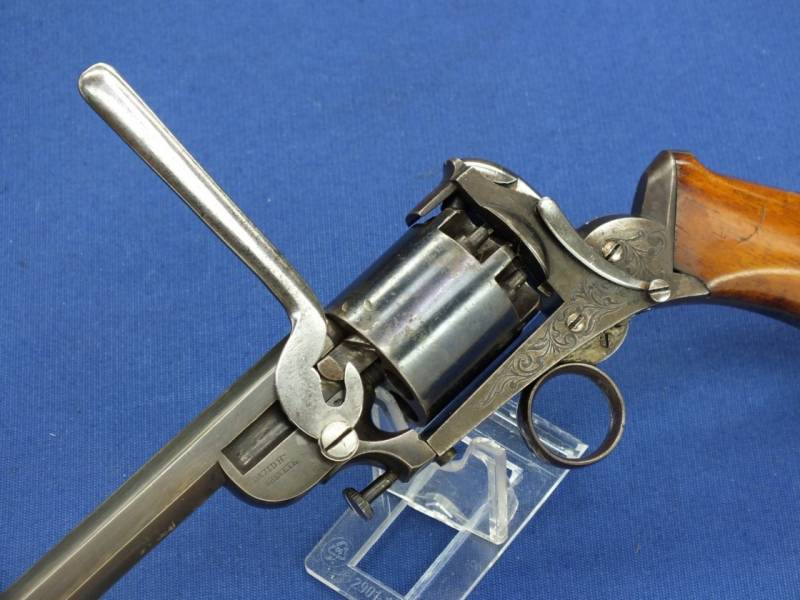
The inflamer piston, as can be clearly seen in the photograph, moved inside a special groove on the barrel itself! And the piston lever did not go down, like the same Colt, but went up

Revolver De L'Espe Omond chambered for centerfire
The originality of this weapon lies in its unusual extractor. There have been so many different types of extractors, but nothing like this has ever happened. Moreover, on a revolver chambered for cartridges (patent 039.172 dated March 24.03.1876, XNUMX).
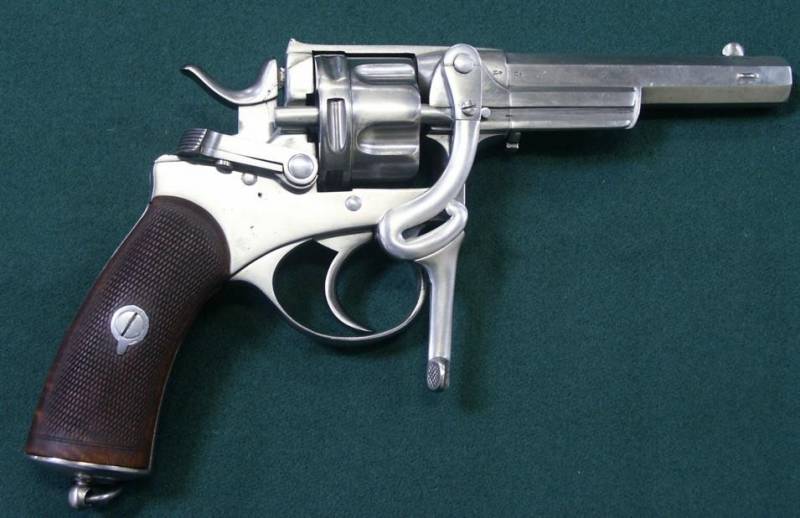
By the way, this revolver looks similar to our revolver. But the extractor, of course, makes a very unusual impression!
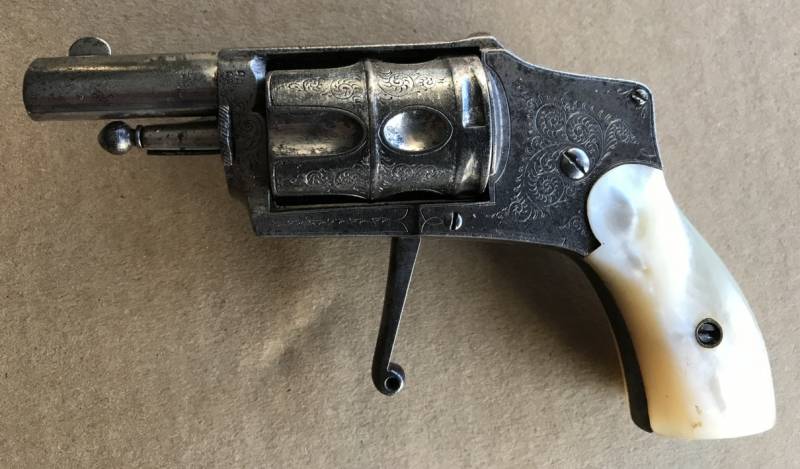
Some revolvers had an original drum shape. For example, this is what the drum of Debute Dieudonne’s revolver looked like
It was a revolver, possibly 6 mm caliber, and given the length of the cylinder, it could well have been 6,35 mm Browning cartridges. The trigger is folding, the handle lining is mother-of-pearl. There is a right-hand safety. That is, for a velodog - and this is a typical velodog, the revolver is too decorated and complicated.
And he also owns this revolver, which is also very similar to a revolver. Except that the handle has a completely different shape. Moreover, the fuse is installed not just anywhere, but on the trigger itself!
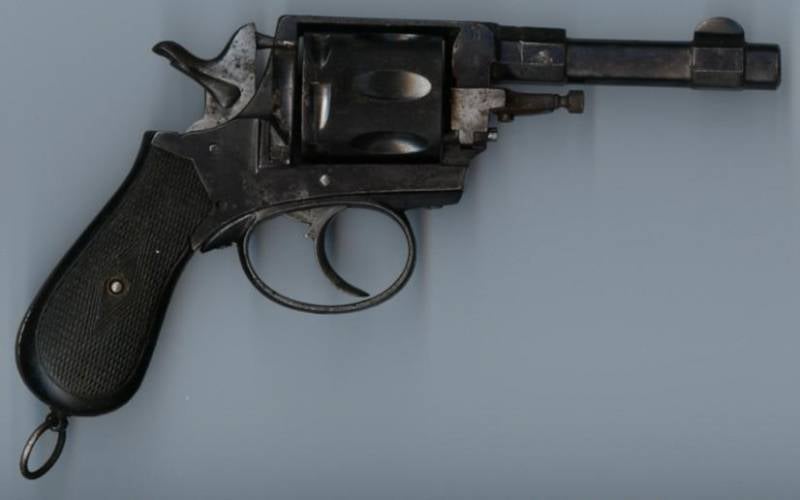
This is a 7-shot 8mm revolver. Right view. The safety lever on the trigger is clearly visible!
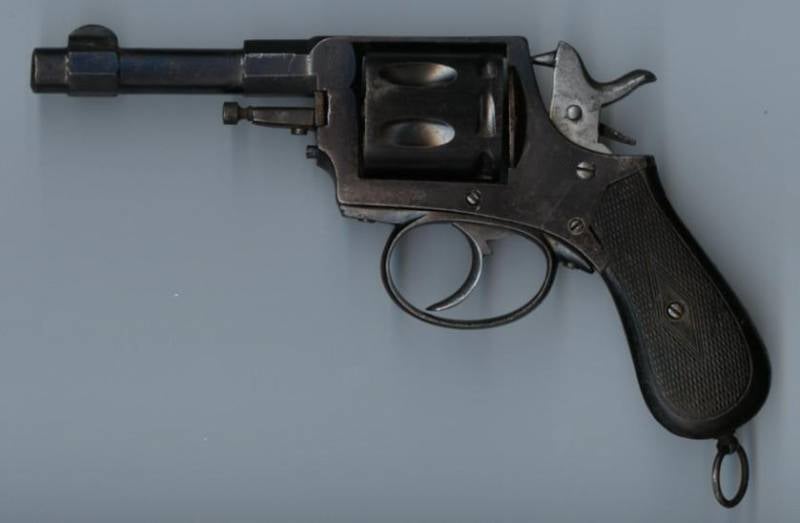
The same revolver. Left view. I wonder why the designer came up with the idea of making an octagonal thickening on the barrel to install the front sight?
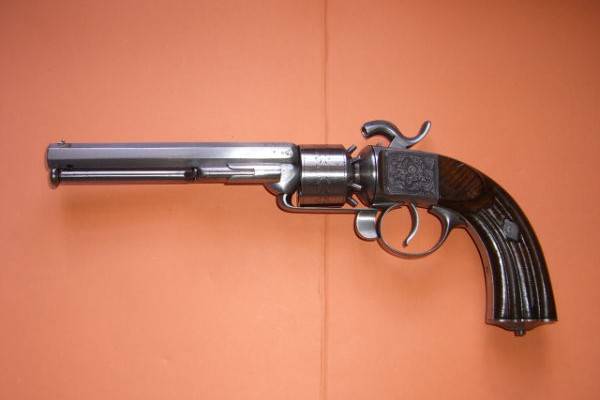
Gilles Decortis's capsule revolver
The appearance is very original. Total length: 313 mm. Barrel length: 153 mm. Caliber: 9 mm. The barrel is fixed to the axis of the drum by a long curved lever. In the closed position, the lever is located under the cylinder, while the knee of the lever follows the bend of the trigger guard. The fire tubes on the cylinder of his revolver are installed at an angle. The igniter is located under the barrel, but to drive the bullet tightly, the lever moves horizontally and turns to the left.
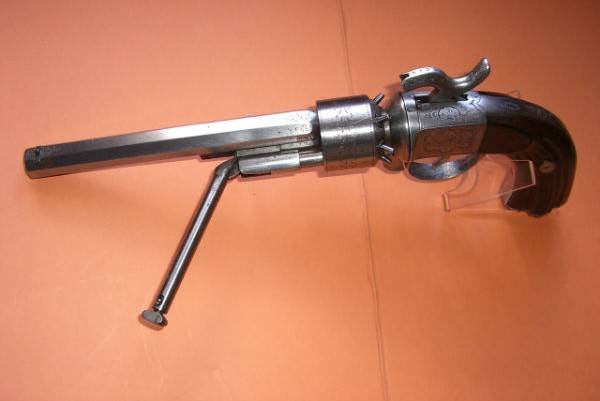
Gilles Decortis' revolver with the lever folded back
From 1851 to 1875, Gilles Decortis received eight patents for various improvements in the field of handguns.
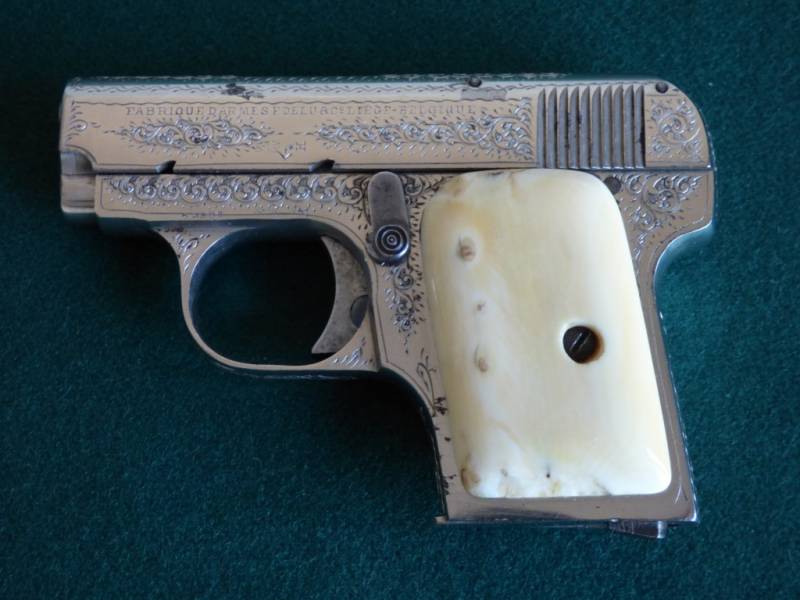
The small pistol of Delu Felix and K. was produced, as you can see, in a luxurious design. The Delu company made two models of such automatic pistols of 6,35 mm caliber. Externally, the only difference is the fuse. This first model, quite luxurious, with engraving and mother-of-pearl plates of the handles, just begs to be given as a gift to a woman!
Despres-Joassard Jean Mathieu owned a smelter and inserted his wife's name (Joassard) after his to distinguish himself from the other Despres, which were quite numerous at the time. He is the author of ten Belgian patents registered between 1857 and 1867.
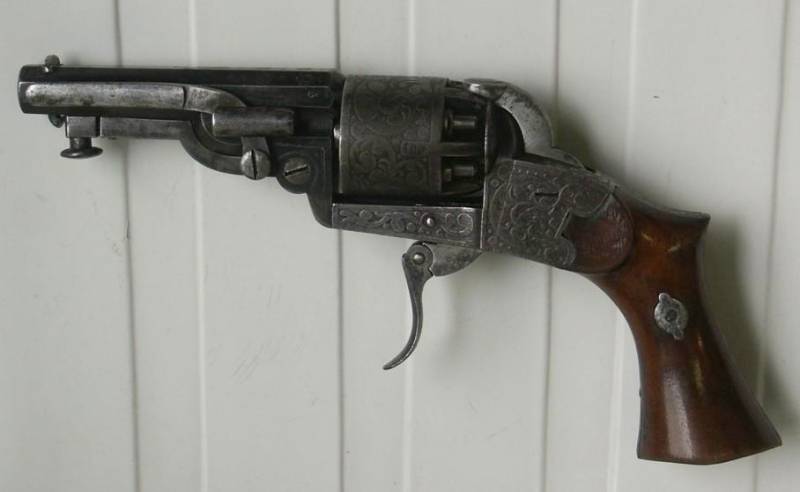
Revolver Depre
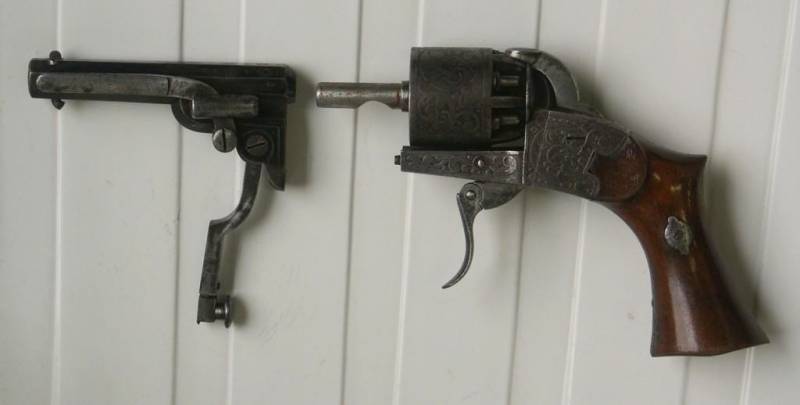
Depret revolver disassembled
The revolvers he produced were different from all others.
Firstly, only self-cocking, as a result of which there was not even a finger on the trigger.
Secondly, there is a very unusual attachment of the barrel to the frame. The injector was of the Adams system, popular among European gunsmiths, but only he had such a barrel mount using a folding lever.
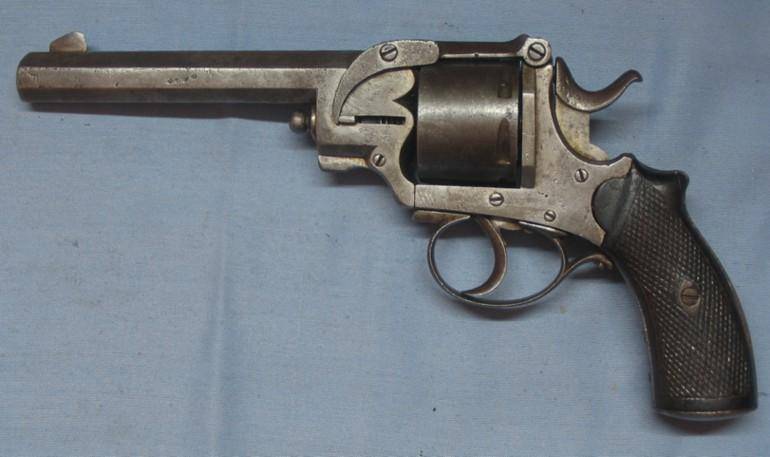
Revolver by Despres-Joassard Jean Mathieu
The Despres-Joassard revolver was invented by Jean Mathieu, a ductile iron foundry at a plant in Herstal, who registered as many as 11 patents in Belgium, and in particular this pistol, which was a new revolver system with a longitudinally sliding reloading mechanism (patented 01.10.1872/XNUMX/XNUMX ). The design is indeed very unusual, which is clearly visible in the photograph...
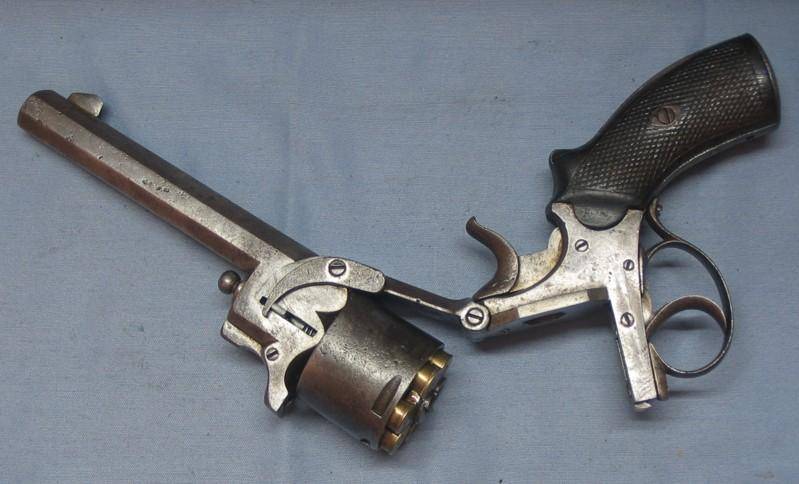
And this is how it unfolded...
Dessard Joseph Nicolas in 1871 offered the Herstal company a double-action revolver, similar in design to the Smith and Wesson. But the mechanism for releasing the upper frame lock was completely different, original. For which honor and praise be given to him!
Moreover, we immediately note that this revolver, when it began to be produced, was intended for export to Austria. It was prohibited to export foreign revolvers with short barrels. But “the need for invention is cunning.”
The Belgians began producing revolvers with long barrels, but with a front sight in the middle of the barrel. Anyone who wanted it could ask the barrel to be cut off at the very first weapons workshop and... thus become the owner of a short-barreled revolver.
And - a strange thing, it was impossible to export them, but for some reason it was possible to own such revolvers!
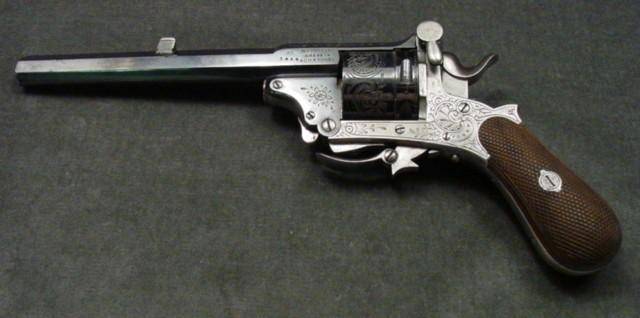
Revolver by Dessard Joseph Nicolas...
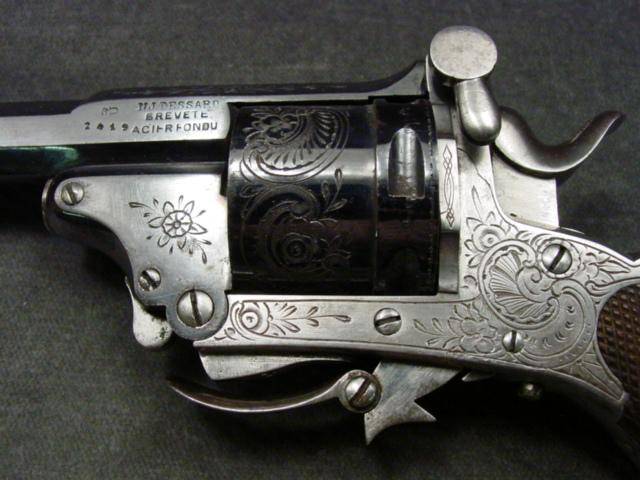
...and its locking unit close-up
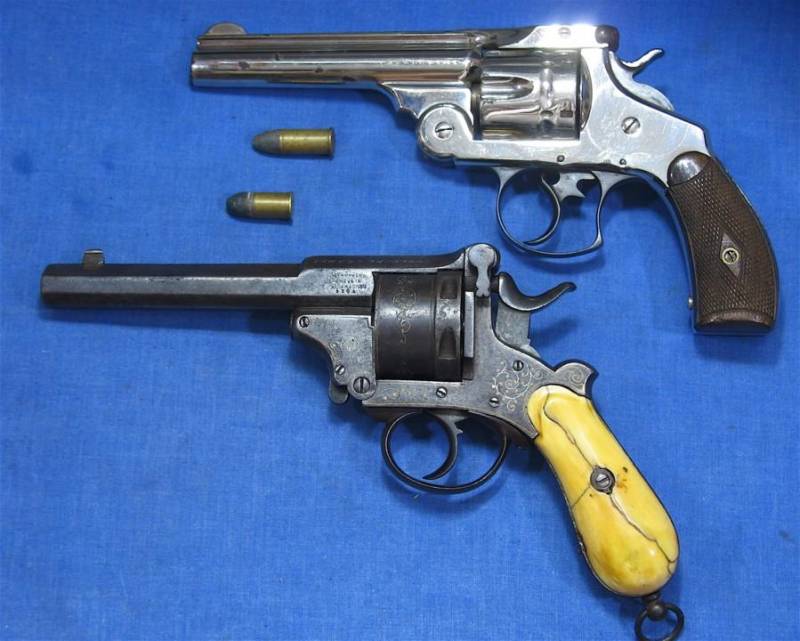
Another revolver of his design in comparison with the Smith and Wesson revolver
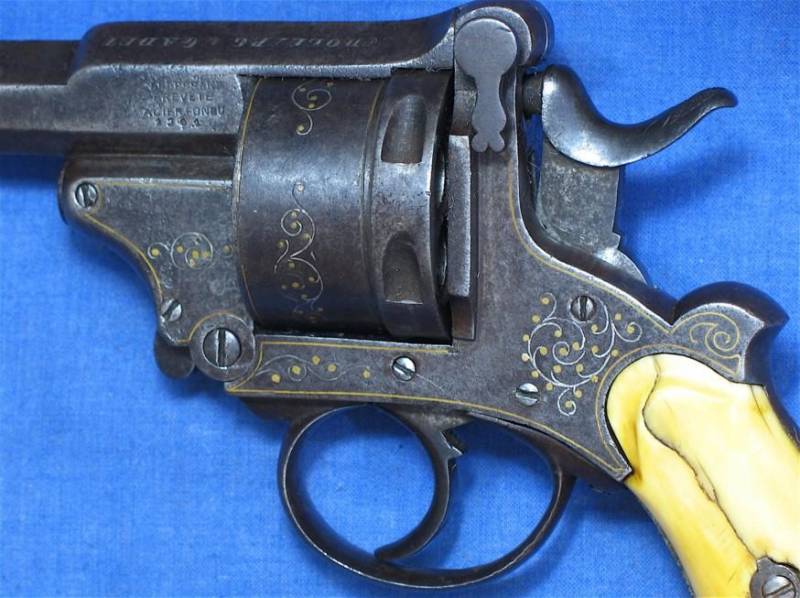
And the locking “button” close-up
And in the same way, only Deville Laurent came up with the idea to make the extraction disk on the drum separate from it under the action of a lever located above the weapon. Before him, and even after, no one did this! Total length of the revolver: 200 mm. Caliber: .320.
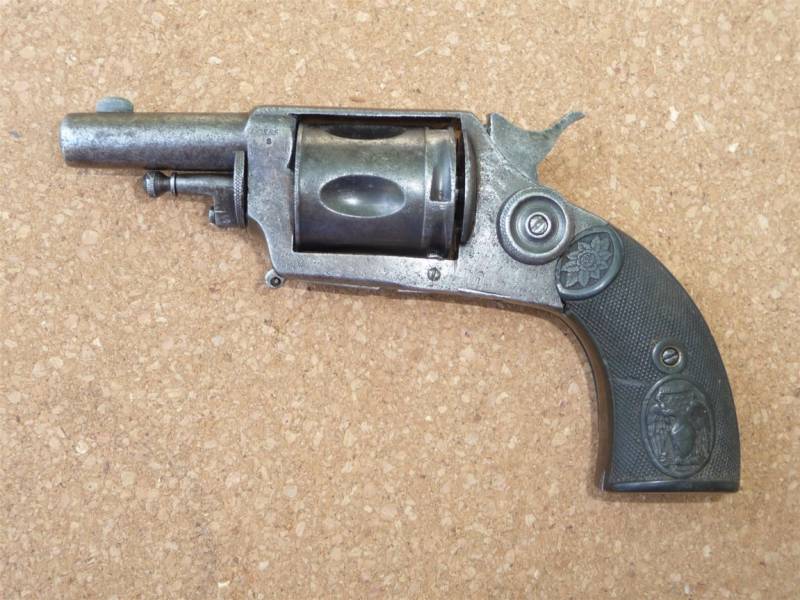
The most ordinary “bulldog” of the Dumoulin Francois and Co. company. A drum for five rounds, a folding trigger... Hundreds of thousands of such revolvers were made, or even more...
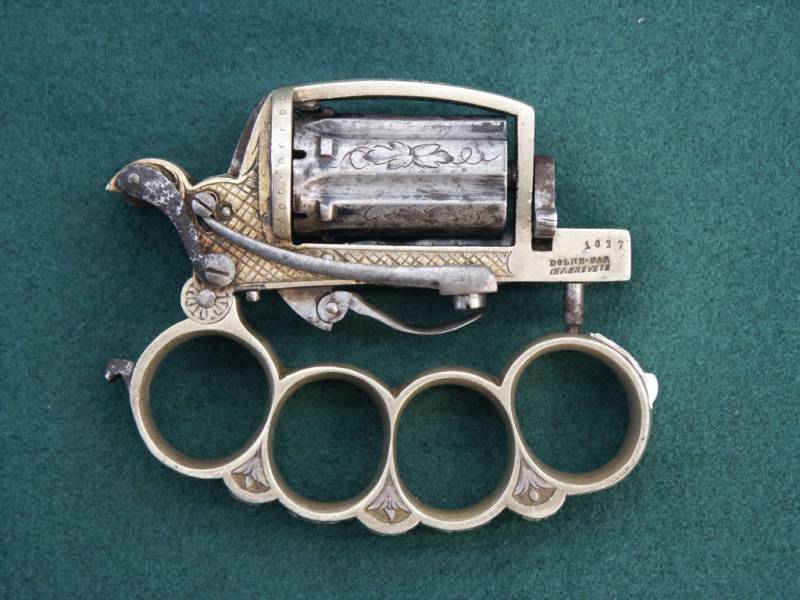
Revolver, brass knuckles, dagger. A popular weapon of the Parisian Apaches. And since there is demand, there will always be supply. The caliber, however, is small: only 7 mm, but the blade is wavy, which, among other things, also affects the subconscious
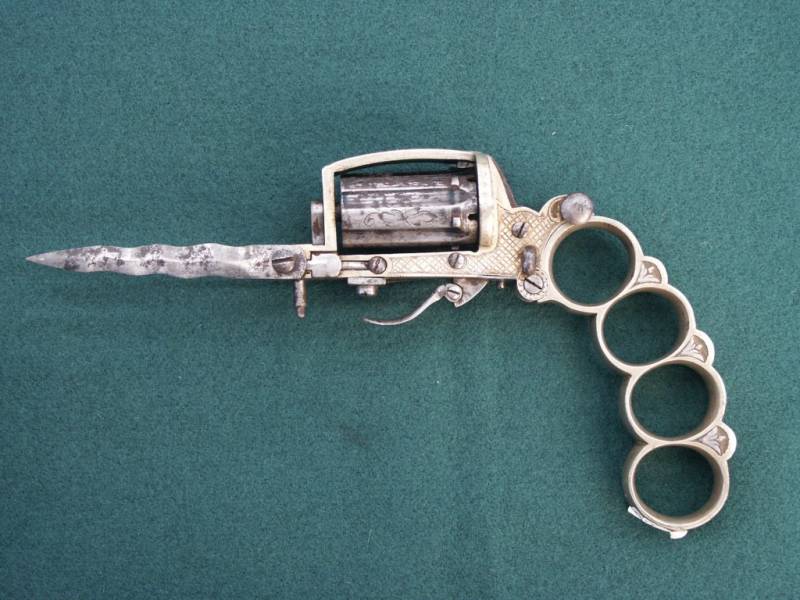
Here it is - a revolver, brass knuckles, a knife
Obviously, if someone released such a weapon and it went viral, then imitators would immediately appear. But doing one to one is bad form; you should add something of your own. And the easiest way is to add an original design on your own, because brass knuckles are also brass knuckles in Africa, a dagger is the same, well, what kind of revolver can you put on a brass knuckles, other than a Pepperbox? This “miracle of weapons thought” belonged to Joseph Delacche from Liege...
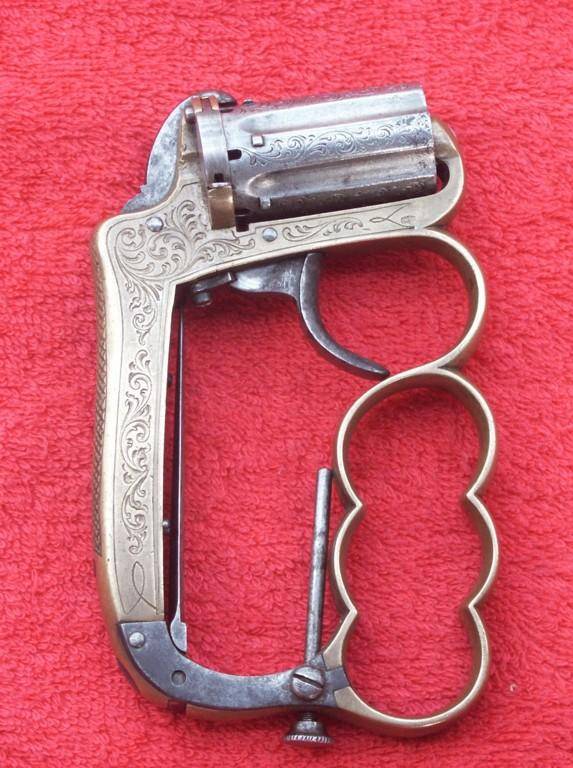
The result is such a miracle of weapons technology. Moreover, the blade ended up inside the handle, which was more convenient than the Dolne system. The caliber is just a little small - only 5 mm, although there were also models with a 7 mm caliber. But 9 would be better! The seven-millimeter device weighed only 350 g. Convenient!
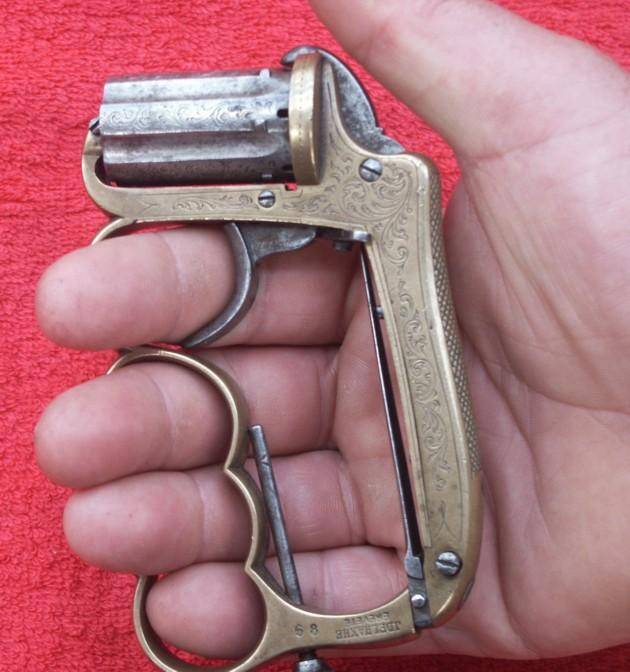
And so it lies in your hand! Caliber 5mm
PS
From the letter “E” next time we will have only one pistol. Therefore, the letter “F” will go along with it.
Pss
The author and administration of the site would like to thank Alain Dobres (littlegun.be) for the opportunity to use his materials.
To be continued ...
Information